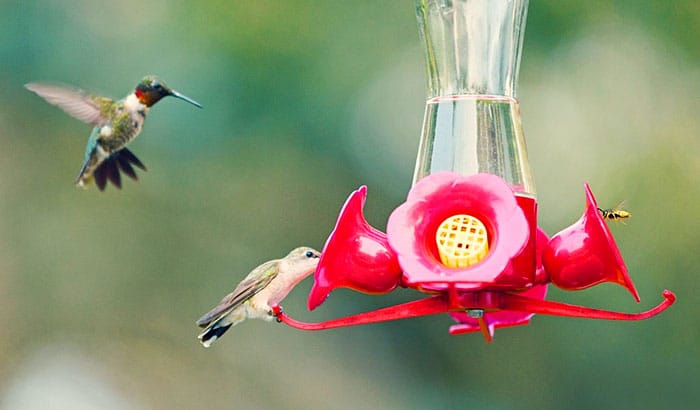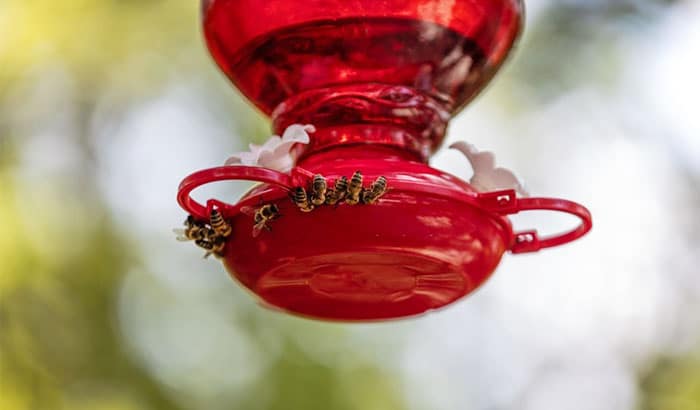Hummingbirds are the smallest type of bird in the world. The bee hummingbird, particularly, is the smallest bird species on the planet. These birds are so small that they commonly eat the nectar directly from the flowers themselves! They are like bees in many ways. Both animals create a sound when flying – hummingbirds hum and bees buzz. Plus, they are both small and love the same food. This begs the question, do hummingbird feeders attract bees?
After all, bees also eat the same foods as hummingbirds. Bees can also fit into bird feeders especially made for hummingbirds. The answer to the question is yes, hummingbird feeders attract bees. Is that a bad thing?
Contents
Why I Worry About My Hummingbird Feeders Attracting Bees
My main worry about hummingbird feeders attracting bees is that hummingbirds can’t eat in peace in the presence of bees. When a bee finds a source of food, it will communicate the information to the other bees in its colony. When a lot of bees invade a specific source of food, a hummingbird will not likely eat there.
The hummingbird just doesn’t see competing over hundreds of bees for a source of food as profitable. It is better for the hummingbird to look for another source of food.
As someone who enjoys watching birds a lot more than watching bees, I don’t want bees to get to the hummingbird feeders I put out. This is why I devised ways to keep bees away from my hummingbird feeders.
How to Keep Bees Away From Hummingbird Feeders
Provide Feeders with Red Bases
Hummingbirds are more attracted to red flowers than any other colors. On the other hand, bees don’t see the color red. They see red as black. So this means that using the color red for hummingbird feeders attracts more hummingbirds while discouraging bees.
Using colors to encourage or discourage different animals is effective. Another way I use colors is through flowers. I use yellow flowers away from my hummingbird feeders so bees will only focus on that area for food.
Use Saucer Shaped Hummingbird Feeders
Saucer-shaped hummingbird feeders cater to the hummingbird’s long beak. The bird’s beak allows it to reach the sweet nectar fluid. But the nectar is placed too deeply in the saucer for bees to reach it. The saucer-shaped feeder is also called a dish feeder.
Reduce the Water’s Sugar Content
The sweetness of the homemade nectar affects which animals it will attract. I discovered that as long as only add 1 cup of sugar to 4 cups of water, it only attracts hummingbirds. This is my starting recipe. If somehow, it is still too sweet that it attracts bees, I add more water to dilute the mixture.
Use Nectar Guard Tips
Nectar guard tips are barriers that only hummingbird beaks can penetrate. They are made of a clear, open, and adaptable material that closes after a hummingbird beak penetrates it. It also keeps the nectar fluid inside it – which also prevents it from attracting bees.
It also prevents bees and other sweet-loving insects from accessing the nectar fluid. Its entire purpose is to create a barrier for any animal except a hummingbird.
Make Sure There are No Leaks
There must be no leaks in the feeder. Bees love warm and sugary nectar. Any water-sugar residue on the outer surface of the feeder can attract bees and other insects.
To make sure that my hummingbird feeders don’t have leaks, I clean them regularly and check for breaks and cracks. If a feeder is made of plastic, it can slowly deteriorate over time, especially if left in the sun.
Place Feeders in the Shade
Hummingbird feeders placed in the shade offer many benefits. First, it prevents the nectar fluid from spoiling faster. Second, it prevents diseases from being transferred among the birds. Third, it discourages insects, bees especially, from eating from the feeder.
Bees love foraging in the sun. If the feeder is in the shade, they are less likely to forage near it.
Relocate the Feeder Around
Once hummingbirds find a food source, they will remember it and look around the area for more sources. This is so unlike bees. Bees and other insects only look for the most convenient food sources. They will not bother looking for a new source especially if the source is relocated every now and then.
Relocating the feeder a few feet away regularly drastically minimizes bee visitors. But it doesn’t discourage hummingbirds especially if there are multiple feeders in the area.
Conclusion: Solve the Problem with Nature in Mind
Do hummingbird feeders attract bees? Yes, they do. Are there natural steps one can take to prevent that? Yes, there are. However, there’s no need to resort to methods that might harm bees or birds. Bees and other insects are part critical of the ecosystem. It makes no sense in trying to get rid of them by hurting them, even if they might discourage the presence of hummingbirds in the yard. Stick to the tips given here, and the presence of bees will no longer be a nuisance.


